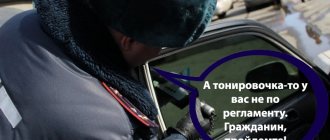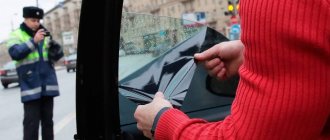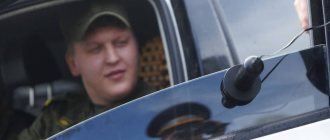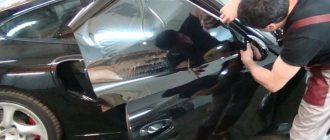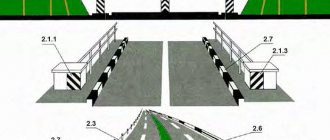Table of contents
- Who has the right to measure
- How is light transmittance measured?
- Norms
- Regulatory acts
- Measurement Rules
- Inspection violations
- Possibilities for canceling the fine
- conclusions
If you decide to darken your car windows, you should know the rules for measuring tint. This will help avoid a fine. In general, there are quite a lot of myths and inaccurate data on this issue. Let's figure out in order who has rights to what, as well as how to avoid problems when meeting with a traffic police inspector.
Can a traffic police officer's decision be illegal?
Traffic police often take advantage of the fact that motorists have little knowledge of laws and regulations. As a result, few people will challenge a fine of 500 rubles. Here is a list of illegal actions on the part of the inspector:
- You cannot measure the light transmittance of glass “by eye,” even if the inspector “can already see everything.” Even if the glass is heavily tinted, the inspector must check it with a taumeter.
- If the traffic police officer does not have a measuring device, he can simply write out a protocol in which it will be written that there are objects installed on the vehicle that limit visibility. There will be no fine in this case.
- The inspector cannot force the driver to remove the tint without taking measurements.
- If a traffic police officer claims that a car has removable tinted windows, that is, the design of the vehicle has been subject to illegal changes, he must confirm his words through measurements with a device.
Who has the right to measure
Contrary to popular belief, any traffic police officer can take measurements. He does not require any additional clearances. It is also allowed to take measurements anywhere.
Rumors that measurements are taken only at stationary points have a basis in reality. The fact is that until recently Order No. 1240 was in force, which indicated that tinting checks could only be carried out at checkpoints or certified technical inspection points. Now this norm has been canceled.
It turns out that the check can be carried out by any traffic police officer, and anywhere on the road. He should not have any additional permits or documents.
How is light transmittance measured?
For measurements, only certified devices must be used, which must be registered in the Russian register. The following measuring instruments are currently approved.
- Tonic (in register No. 44919-10). Capable of measuring not only neutral-colored glass, but also colored glass. Has a built-in memory of 3 results. You can enter the car number into the protocol. If necessary, you can connect the device to a central server and transfer data directly there. Measures light transmission qualitatively. There are no problems even on thick glass. Battery operated.
- Blik-N (in register No. 35807-07). One of the most common devices. Has a digital display. Calibration occurs automatically. It is possible to measure tint on glass with a thickness of 3–10 mm. There is a limitation on the ambient temperature; measurement is possible in the temperature range from –10°C to +40°C. Has a built-in battery
- Light (in register No. 20761-11). Measures the light transmission of glass with a thickness of 3–6 mm. Designed to test transparency between 1-99%. Can be used at temperatures ranging from –40°C to +40°C.
Important!
All devices have an error of 2%. Therefore, if, when checking the glass, it turns out that it transmits 69% of light rays, the inspector has no reason to issue a fine.
All devices must have a valid certificate. A document confirming a passed state inspection is required. The device must be sealed.
How do you measure tint according to the rules?
Article 26.8 of the Code of Administrative Offenses of the Russian Federation establishes the obligation to use technical means when necessary to check light transmittance . It is also stated here that the data obtained must be reflected in the protocol. On the Rosstandart website you can view the state Register of Measuring Instruments. So, for 2021 you can see the following devices for measuring light transmittance:
- “Tonic” is a device designed to measure tint;
- "Light";
- "Blink-N."
Of course, not only these devices can be seen in the register, but these are the ones that have a valid certificate of inclusion in the Register.
- Instructions for measuring tint using Blink-N
A voltage of 12 V is necessary for the device to work well. This device is unpretentious and can take measurements at different times of the day. The device is in working condition at temperatures from +10 to +40 degrees. “Blink-N” takes measurements on windows whose thickness ranges from 3 to 10 mm. The device weighs 900 grams.
- Instructions for measuring tint using the “Light” device
A distinctive feature of the device is the ability to take measurements at temperatures from +40 to -40 degrees. “Svet” can take measurements both at night and during the day. The glass thickness when measured should be from 3 to 6 mm. The weight of the device is 1.4 kg.
- Instructions for measuring tint using the Tonic device
You can use a tonic device. The conditions for measuring tint are as follows: temperature range from -10 to +40 degrees. “Tonic” is capable of performing its measurements at absolutely any time of the day. The weight of the device is 500 grams. The device operates at a voltage of 3.6 V.
Norms
According to current GOSTs, only the tinting of the windshield is standardized; it must transmit at least 70% of the light. There are no light transmission requirements for tinting the side windows. Here is the rear window, if there are no mirrors on the side, it is equal to the windshield, therefore it should not have a surface with a light transmittance of less than 70%
A case from one's life.
The driver damaged his side mirror in the parking lot. I also removed it from the other side, deciding to make do with only the central one before buying new ones. The car was tinted according to the rules. Side and rear 50%, windshield let in 75% of light.
When stopping, the traffic police officer noticed the absence of side mirrors and measured the level of light transmission of the rear window. A fine was issued for violating the tinting rules, but it was not possible to challenge it.
It is also worth considering that mirror and color films are prohibited, the rules prohibit the use of “chameleon”. You can also get a fine for such tinting on a car.
Regulatory acts
Now the traffic rules mention GOST 33997-2016. It is this document that regulates what tint can be used on a car. It states that for a windshield it must transmit at least 70% of light rays. It also indicates what types of tint can be used.
GOST 33997-2016 is fully unified with the Technical Regulations of the Customs Union TR CU 018/2011 “On the safety of wheeled vehicles”. In fact, these are interchangeable documents. It’s just that it’s much more familiar and convenient for traffic police officers to refer to GOST.
It is definitely worth mentioning Order of the Ministry of Internal Affairs No. 664. It was he who allowed us to check the tint anywhere. Until December 2021, inspections were allowed only at traffic police posts. Now this action can be performed anywhere. There is an exception - the permissible places are determined by the local traffic police department, but they leave this item by default, without limiting the actions of inspectors.
The inspection rules are regulated by GOST 27902-88. This document describes in detail the conditions and technical actions when checking a vehicle for the degree of light transmission. Do not be confused by the “antiquity” of this GOST, it has not yet been canceled, and it is unlikely that it will be changed in the near future.
Rules for measuring tinting
Tinting not according to GOST is one of the most common fines. According to statistics, measures have been taken to tighten control over violators. Last year, only technical supervision employees had the right to measure the traffic capacity at the checkpoint; in 2021, any traffic police officer, including ordinary ranks, can check the darkening of the windows.
In accordance with Part 1 of Art. 28.3, art. 26.8 and clause 6, part 2, article 23.3 of the Code of Administrative Offenses of the Russian Federation, all traffic police officers with a special rank have the right to initiate a case, use means for measuring and make a decision on this offense.
Thus, traffic police officers are allowed to measure the degree of light transmission, but only at the post.
The conditions for measuring glass throughput must be strictly observed following the order of the Ministry of Internal Affairs No. 1240.
- It is at the traffic police post that inspection of car windows is allowed.
- Control is carried out by technical supervision or the traffic police and a special mark on the service ID should indicate this.
- Measuring devices must be registered in the state register and have a certificate indicating the last verification of the device, as well as the required frequency of verification.
Diagnostics are performed on a dry, clean surface in 3 places of one glass and the final reading will be the average reading of the device. Temperature is a mandatory condition for measuring outdoors according to GOST 27902 - 88
- at air temperature +15 to +-25
- provided that air humidity is 40% to 80%
- pressure 86 to 106 kPa.
Without measuring weather indicators, the inspection is considered illegal and a violation; it is allowed to challenge it within ten days from the decision of the violation. The readings of a device used in winter are considered illegal. Errors and individual characteristics of instruments for measuring car windows differ from each other, but cannot exceed 2%; if more, it is allowed to require compliance with GOST 27902 - 88.
Tinting is measured at temperatures from +15 to +25, having previously taken measurements of pressure, air humidity and voltage at the battery terminals. That is, you need to measure correctly using 5 instruments, with certificates and verification of the instruments; if at least one requirement is not met, feel free to go to court to appeal the fine.
Important Features
Be sure to ask to see the certificate and registration certificate of the device used for measurement and its latest verification, check whether everything stated corresponds to the device. So, for example, the most common “Blik” meter, the technical parameters of which allow measurements to be taken at a temperature not lower than -10 degrees, gave distorted readings; in fact, normal readings of -5 degrees are obtained. The newly introduced device “Light”, as it turned out, is in fact old; it was entered into the register back in 2008 and is now allowed to be used all year round, but still only on a dry and clean surface.
Before tinting a car yourself or by a specialist, you must first measure it and then, having calculated the permissible norm, apply the tinted glass according to GOST rules, not forgetting to use the calculation formula (glass%*film with the selected %) and adding 2% instrument error to the result obtained. It is not necessary to go to the post to measure the percentage of tint because, legally, the employee is first obliged to carry out an administrative detention, but having considered Part 1 of Art. 27.3 of the Code of Administrative Offences, then it can be understood that detention cannot be used to identify offenses. Therefore, the detention procedure provided for by administrative regulations can be carried out after violations are identified, and not before.
Pay attention to the color of the film, which is not allowed to distort yellow and red, green and white, this is considered a violation of the law, only expensive, top quality film from a reliable manufacturer will give a guarantee and a positive effect. Important: the decision to punish in the form of a repeated fine or arrest may accept only the court. Moreover, according to the bill for January 2021, the amount will double or triple. If the situation repeats within 12 months, in accordance with the approved 32 part 12.5 of the Code of Administrative Offenses of the Russian Federation, the fine will be 5,000 thousand rubles
or deprivation of a driver's license for up to 3 months.
If the situation repeats within 12 months, in accordance with the approved 32 part 12.5 of the Code of Administrative Offenses of the Russian Federation, the fine will be 5,000 thousand rubles. or deprivation of a driver's license for up to 3 months.
Measurement Rules
Currently, inspectors do not receive special training on how to measure tinting correctly. They usually use the instructions included with the taumeter device. According to these recommendations, they check whether the tinting complies with the standards or not.
First, we will study GOST 27902-88. This is what is written there regarding the conditions for measuring the degree of light transmission of automobile glass.
- The ambient temperature should be 20°C, but a deviation of 5° in one direction or the other is allowed.
- Atmospheric pressure should be between 86–106 kPa.
- Relative air humidity 60%, deviation of 20% in one direction or the other is allowed.
After reading these requirements, you might think that taking tinting measurements on a regular road is almost impossible. But here it is worth paying attention to the tolerances. In fact, it is possible to check the tint under almost any conditions. Although there are some exceptions, we will talk about them at the end of the article. For now, it’s enough to accept it as a rule - there are practically no restrictions on measurements.
Important!
The readings of the device are not affected by the time of day, degree of illumination and precipitation. This is quite logical; the degree of light transmission does not depend on whether it is raining or not.
In practice, tinting is measured by an inspector in accordance with the instructions of the measuring device. Almost all taumeters have approximately the same requirements; only the layout of the device may differ. Let's look at how to check the level of light transmission with the most popular taumeter - "Blik-N".
- Make sure the car engine and ignition are turned off. This will help to avoid interference from the relay regulator; problems may also arise in the high-voltage circuits of the machine.
- Power is connected. If you are using offline mode, turn it on. If from other sources, we connect using the special cord included in the kit.
- When moving from a warm room to the street, you should wait at least 15 minutes before using the device. This will minimize the risk of measurement error.
- We check the heads for freezing and fogging. If such a problem is identified, you need to thoroughly wipe the receiving and transmitting heads.
- We turn on the taumeter and make sure that all indicators are working.
- Before taking measurements, we calibrate the device. Use the pen to set the indicator to 100%.
- Remove the heads and place them on the glass. They are magnetic, that is, they attract each other, you need to bring them to the glass carefully so as not to damage it, especially at low temperatures.
- We shift the transmitting head relative to the receiving one. Let's see in which position the coefficient will be the largest. We multiply this indicator by 100, as a result we get the percentage of light transmission of the tint.
It is recommended to measure at 2-3 points on the glass. This way you can avoid mistakes and random errors. The developers took this point into account; up to 3 checks are stored in the device’s memory.
The inspector must enter vehicle identification information. Usually a license plate number is used, this makes it easier to associate testing and a specific car. The report attached to the protocol will indicate the degree of light transmission, as well as identification data
Sometimes mistakes happen. An employee made a mistake in one digit when entering data. As a result, the court canceled the protocol, considering the obtained measurement results unreliable.
Drivers are often outraged that tinting is measured on dirty glass. In fact, there is nothing criminal here. There are no regulations stating that glass must be perfectly clean. And in fact, dirt on the glass does not greatly affect the level of light transmission. And if your car is so dirty that the taumeter shows a low percentage of light rays passing through, it’s time to wash it.
General information
Car tinting is a procedure for determining the light transmittance of its tinted windows. This process is carried out using special taumeter devices.
Currently, common taumeter options are Blik (the most common device, including Blik+, Blik-N), Light, Tonic, Raster.
This device must be used in accordance with the regulations. The measurement is made at three points, the average calculated on the basis of the three figures obtained will be the desired value of light transmission.
When taking measurements, it is necessary to check the accuracy of the device itself, as well as determine the accuracy of the readings of the instruments themselves that check the taumeter (measuring temperature, humidity and pressure).
Also, the traffic police inspector must present documents to the car owner, including documents certifying the proper condition of the taumeter itself, confirming that it has been verified in a timely manner, and, in addition, a document indicating that the employee has the skills to use the device.
In the absence of any of these documents, the result of the procedure may lose its evidentiary value. The taumeter is used in accordance with the instructions.
There is a controversial opinion according to which tinting can only be measured at the traffic police post, and not at the place where the inspector stopped the driver.
In addition, it is known that a driver who has not violated traffic rules (that is, an administrative law) cannot be subjected to administrative detention (and it is on this basis that drivers with a car are taken to the traffic police post).
This may mean that drivers have a legal option to avoid having their tint measured, but opinions differ on this point.
Initial data
Tinting car windows - darkening it in various ways, including fixing films of various types, spraying, installing curtains, as well as purchasing ready-made windows with tinting.
For two types of car windows, there are restrictions on light transmittance. The windshield should have a rating of 75%, and the front side panels should have a rating of 70%.
There are no tinting standards for rear side and rear windows. Tinting is measured using a special device - a taumeter.
Photo: light transmission standards
For what purpose is it used?
Tinting is measured to determine its light transmittance. This value must comply with GOST standards.
Compliance with the limits established in it confirms that this car does not pose a threat to other road users.
Current regulatory framework
The current regulatory framework by which the issues of tinting measurement are regulated include:
- GOST 32565-2013, a document that describes the appropriate characteristics for tinting windows installed on cars and other types of land transport with the rules for measuring this tint;
- Traffic rules adopted by decree of the Government of the Russian Federation;
- Federal Law “On Police” No. 68-FZ;
- Code of Administrative Violations (CAO).
Inspection violations
In some cases, inspectors intentionally or through oversight commit various violations. These points should be monitored and then recorded in the protocol.
Be sure to check the certification of the tint checker. If he does not have documents, the research should not be carried out. You don't know where you got it from. Although such a violation is extremely rare. Usually, traffic police crews are supplied not only with equipment, but also with a full set of documents.
Ask to see the device. It must be sealed. Again, if there is no seal, perhaps someone dug into it, and the taumeter can show any data, but not real data. This kind of violation occurs regularly, and not always consciously. Police officers may accidentally touch the seal. But, in any case, you cannot measure tint with such a device.
The inspector makes only one measurement. He can specifically choose a place that, for some reason, has less light transmittance. For example, he will see a small chip. In this case, it turns out that you are a violator. Be sure to require three measurements at different points on the glass.
Some traffic police officers have truly dexterous hands. They manage to place a piece of film under the measuring head. This allows you to get a result that will suit the inspector, but you will not like at all. To avoid this, watch the policeman's hands carefully. If in doubt, ask to see a taumeter to check for fogging or foreign objects.
In some cases, you can be sure of your innocence. Here it is worth asking to repeat the tint check, but in the presence of witnesses. This is not necessary, so the inspector can conduct an inspection without the participation of witnesses. In principle, this is not very important to you either, so there is no need to insist. Although if you are sure that the policeman is violating something, it is better to ask for the participation of witnesses.
It is also a violation to measure at a temperature that differs from the recommended range of 15–25 degrees. But here the inspector violates it out of ignorance; he is guided by the recommendations specified in the instructions for the device. And, there the temperature range is much greater.
A case from one's life
The inspector stopped a car with minor tint. After measurements, it turned out that the glass transmits only 60% of light rays. The driver was not satisfied with this; he demanded a repeat check in front of witnesses.
The inspector stopped the first car he came across. The driver, in the presence of witnesses, asked to wipe the instrument heads and take measurements. This time the taumeter showed light transmittance of 80–85%, which is not a violation.
The Blik device is a common device for measuring glass transparency
Today, there are a large number of special devices that determine the level of transparency of tinting.
But among the special equipment on the market, several taumeters stand out. The most common device, which is most often used by traffic police officers, is the Blik device. It should be noted that, despite the fact that the equipment is included in the State Register of Measuring Instruments, it must have a special label indicating that the taumeter has passed state inspection and can be used to check transparency. If for some reason it is missing or the seal is broken, then all tinting indicators can be considered inaccurate.
The main features and technical characteristics of the equipment include:
- measurements can be carried out at any time of the day;
- indication of measurement readings - digital;
- data errors may vary from -/+ 2 – 4%;
- the optimal air temperature at which the device will operate can vary from -10°C to +40°C;
- can be powered by a built-in battery;
- inspection by special services should be carried out once every 12 months.
Possibilities for canceling the fine
It was already mentioned above that there are completely legal ways to cancel the protocol. And they really work. The easiest way is to refer to measurements under inappropriate conditions. To do this, you need to disagree with the protocol when signing. Then he will go to court.
During the court hearing, you must refer to GOST 27902-88. It lists all the environmental parameters under which glass transparency studies should be carried out. In practice, there are very rarely situations where the measurement takes place at a temperature in the range of 15–25°C. This means there is every chance of avoiding a fine. Point out the weather conditions to the judge; the easiest way is to do this in the winter, when there clearly cannot be above-zero temperatures.
But, most often, the protocol does not indicate temperature conditions or humidity indicators at all. In this case, you can also report violations during the inspection. Since the protocol does not contain data on temperature and humidity, the court may well find such a dimming measurement illegal. Quite a lot of such decisions are made throughout the country.
Just don’t talk about temperature and humidity directly to the inspector. He will enter this data into the protocol, and you will lose a significant chance of challenging the protocol.
Rules for checking the transparency of car tinting
As you know, this type of film covering car windows causes controversy and complaints among law enforcement officials. In Russia, a law was passed that specifies standards for the transparency of tinting and the slightest violation of it entails a fine . It should be noted that to determine transparency, only taumeters that are certified by the Scientific and Technical Commission for Metrology can be used. Thus, the determination cannot be done by eye, but only with the appropriate equipment.
When checking transparency, it is very important to adhere to certain rules that are specified in GOSTs. These parameters include:
- determining the transparency of the tint should take place at an air temperature of at least – 40°C;
- A taumeter is a device for determining that can work both in the light and in the dark. This does not affect the device readings;
- during fog, the transparency of the tinting on the car glass, and specifically the accuracy readings taken, may decrease;
- before tinting, you must check the percentage of transparency of the glass that will be tinted in the future and, based on the indicators of clean glass, you need to select the appropriate film for tinting;
- You must know that the taumeter on your monitor does not show the percentage of tinting, but the percentage of the light flux that passed through the special film. If an indicator of less than 8% is marked on the screen, then this does not comply with the norms and standards of GOSTs, so the car owner will have to pay a fine. On the website of the RosShtrafi service you can quickly find out traffic police fines and pay them there with a bank card.
conclusions
Any traffic police officer has the right to measure tinting, regardless of where the vehicle is stopped. There is no point in hoping that you will not be checked; it is still better to use only film that is acceptable for use.
Measurements must be made under certain conditions, only with a fully functional and certified device. Knowing the rules for checking glass for transparency will help you avoid a fine.
If, nevertheless, the protocol was issued, in many cases it can be appealed. You just have to spend a little time visiting the court. Point out any violations made during measurements, usually this is the absence of the specified temperature, in some cases you can mention the non-compliance of the measurement conditions with the recommended parameters.
How is the degree of tint measured?
A taumeter is a device that can be used to measure the degree of tinting of car windows. The device is a portable device that can measure the light transmittance coefficient. This coefficient is expressed as a percentage that is displayed on the device screen. Light transmittance coefficient is an indicator that indicates the amount of sunlight passing freely through a window. The taumeter must undergo metrological testing and certification. These indicators will indicate that the device is working properly.
What is the mechanism of operation of the device? Everything is quite simple here. Using an emitter, the window is illuminated. The resulting light stream is passed through the sample and enters the taumeter receiver. On the digital display you will see the percentage of light transmission.

